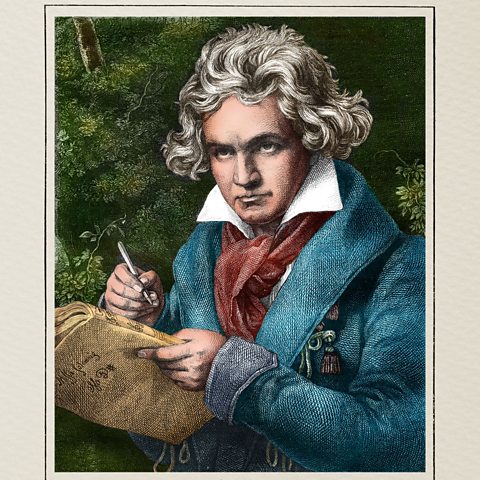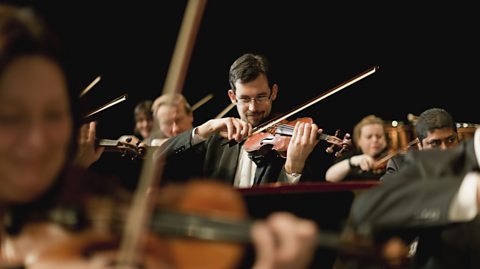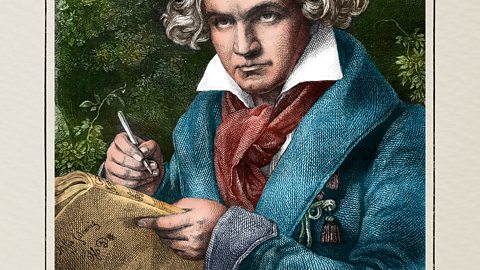Key points about Beethoven: Symphony No. 1 Movement 1

Ludwig van Beethoven was a well-known composer of the late Classical period. His music was heavily influenced by his predecessors Mozart and Haydn.
A symphony is a piece of music for an orchestra. In the early Classical period, symphonies usually had three movements, but by Beethoven's time, there were often four movements.
Beethoven wrote his first symphony in 1799.
The symphony contains many Classical features found in the works of his predecessors Haydn and Mozart, but BeethovenвҖҷs style can be heard throughout, especially his frequent use of sfzorzandiNotes given a sudden emphasis, similar to an accent..
He went on to write eight more symphonies, which increased in scale as the form developed.


Remember
There are four movements in this symphony but your study piece is the first movement. You will only answer questions based on this movement in the listening exam.
Video
Watch the video below to learn more about the exposition, development and recapulation of Beethoven's Symphony no. 1.
Presenter: Ludwig van Beethoven was a prolific composer in the classical period. He wrote nine symphonies in total. Symphony number one in C major was his first, written in 1799. It has four movements. We're going to focus on movement one here.
Movement one is written in sonata form, meaning that it has three sections exposition, development, and recapitulation. Before the exposition starts, though, Beethoven includes an introduction. It's adagio molto, very slow in 4/4.
The introduction uses the forte piano dynamic that's playing loud and then quietly straight away - it adds to the drama.
The symphony opens with a series of dominant seventh chords, which gradually move towards the dominant chord of G major, leading us into the exposition in C major.
This fast exposition section, allegro con brio, changes to 2/2 and establishes C major. The exposition has two main themes. Theme one is played by the violins, featuring dotted rhythms, staccato articulation, and ascending phrases.
Let's hear it.
Theme two is played by woodwinds, in contrast with legato or smooth articulation and descending phrases. It's in the dominant key of G, which was very common in the classical era of music.
The structure and key to the main themes make this a great example of sonata form. The exposition ends on the dominant seventh of G major, then repeats by 110 is the start of the development section, and the themes are back, repeated in different keys.
A major.
D major.
G major.
And C minor.
The recapitulation starts in bar 178. You can hear theme one return in the woodwind and strings. And now when we hear theme two, it's now in the tonic C major. Another common feature of sonata form.
The movement ends on a perfect cadence.
Beethoven firmly re-establishes C major at the end of the movement, with the final chord played five times.
The Basics
The symphony is scored for an orchestra of strings, woodwind, brass and percussion. The strings are divided into 1st and 2nd violins, violas, cellos and double basses. The woodwind consists of two flutes, two oboes, two clarinets in C and two bassoons. The brass instruments are two natural horns and two natural trumpets and finally Beethoven uses two timpani tuned to a C and a G.
There are four movements in this symphony:
i. Adagio molto вҖ“ Allegro con brio
ii. Andante cantabile con moto
iii. Menuetto: Allegro molto e vivace
iv. Adagio вҖ“ Allegro molto e vivace
The Italian terms describe the tempo or rhythmic feel of each movement.
The first movement is in C major. The structure of this movement is sonata form - a typical form for first movements in the Classical period. Before the exposition, there is a slow introduction, in 4/4 time, something which Mozart and Haydn had introduced in their later symphonies. The slow introduction would become more common in BeethovenвҖҷs symphonies and the symphonies of future composers. The Allegro con brio section is in 2/2.

There are three sections in sonata form:
Exposition - the main musical themes are presented.
Development - the composer develops the themes from the exposition.
Recapitulation - the main themes return.

Exposition

The slow introduction includes a series of cadences using the forte piano dynamic, this is when the music is played loudly and then suddenly becomes quiet. The strings play pizzicatoWhen the strings of a string instrument are plucked..
In the exposition of a sonata form movement, there are usually two contrasting themes. The first theme, also known as the first subject, is in the tonic key The key based on the first degree of the scale. It is often referred to as the home key as well. which in this case is C major. The theme is mostly played on the strings with the first violins playing dotted rhythms and ascending phrases. The articulation is mainly staccato.
The second theme, also known as the second subject, moves to the dominant key, G major. This move between the tonic and dominant was typical of sonata form in the Classical period. It was also convention that the second theme would be contrasting to the first. In this case, Beethoven shares the melody among the woodwind instruments. The phrases descend and the articulation is legato.
The exposition finishes on a dominant 7th chord (G7) and is repeated.


Remember
The exposition moves from the tonic to the dominant key in the Classical period.
What are the names of the sections in sonata form?
- exposition
- development
- recapitulation
Development
The development section of the symphony is where composers develop fragments of the two main ideas from the exposition, which includes moving through related keys. Beethoven certainly achieves this in this symphony.
Bars 110-121
The first theme is presented by the first violins in a number of related keys including A major, D major and G major. In between these, the woodwind instruments provide syncopated interjections.
Bars 122-135
The music moves to C minor (the tonic minor). In the second half of the first theme, the four ascending staccato crotchet idea is developed. This idea moves quickly through F minor and begins to settle in E flat major.
Bars 136-143
The descending idea of the second theme becomes the focus here. Whilst the tonality is E flat, this passage feels like a prolonged pedal on B flat (the dominant of E flat) as Beethoven explores scalic passages in the strings.
Bars 144-159
The opening of the first theme is developed here. The dotted rhythm is passed around the instruments. The music moves through E flat major, F minor, G minor, D minor and A minor. You can see the appearances of the motif in the boxes below:
Bars 160-177
This passage is based around the chord of E7, the dominant 7th of A minor. The crotchets from the first theme are sped up to quaver, as shown by the images below:
Throughout this passage, the brass instruments play the dominant pedal note (E), which the woodwind instruments take over in bar 172.
The development ends with a descending dominant 7th arpeggio from the woodwind, ready to resolve in the recapitulation.
In pictures: Beethoven: Symphony No. 1 Movement 1

Image caption, Ludwig van Beethoven was a well-known composer of the late Classical period whose music was heavily influenced by his predecessors Mozart and Haydn.
Image caption, Natural trumpets in C were used in this symphony. Natural trumpets had no valves unlike the modern trumpet. The player had to change the shape of their mouth to make different pitches. In this picture, the trumpeter is a soloist.
Image caption, Natural horns were also used in this symphony. There are no valves like there would be on a modern horn. The player had to change the shape of their mouth to make different pitches. In this picture, the horn player is a soloist.
1 of 3
Recapitulation
The role of the recapitulation is to re-establish the two main themes, summarised in the table below.
| Bar number | Theme | Tonality and key features |
|---|---|---|
| Bar 178 | Theme 1 | C major (tonic) вҖ“ strings and woodwind play the theme in unison. |
| Bar 206 | Theme 2 | C major (tonic) вҖ“ the music stays in the tonic to close the movement. The woodwind pass round the melody, which is legato. |
| Bar 271 | Coda | C major (tonic) |
| Bar 277 | Coda | From here until the end of the movement, the music is based on a C major chord. Beethoven repeats theme 1 in the first violins, cellos, basses and bassoons while the rest of the orchestra play a C major chord. |
Watch the video clip to recap this section.
In which key is BeethovenвҖҷs Symphony no. 1?
C major
Further Listening
BeethovenвҖҷs first symphony also includes other important movements. For example, the second movement contains more extreme dynamics and BeethovenвҖҷs signature sf or sfz, especially on weaker beats.
BeethovenвҖҷs famous Symphony No. 5 is a good example of how BeethovenвҖҷs symphonic style develops. It contains a continually growing independence of the woodwind, and a thicker texture, distinguishing Beethoven from his symphonic predecessors, Haydn and Mozart.
It also increases in scale and length of the movements. Beethoven develops the famous вҖҳfateвҖҷ motif extensively and the movements all become much longer. Like in his first symphony, at the end of the first movement of this 5th symphony it includes repeated perfect cadences in C minor to establish the key. At the end of the fourth movement and the whole symphony, there are many repeated perfect cadences in C major, establishing the triumph of the major key over the minor. This is also important as there were more chromaticisms being used in BeethovenвҖҷs writing.
Question and Answer
In a typical sonata form piece, what is the difference between the second theme in the exposition and the second theme in the recapitulation?
In the exposition, the second theme is usually in a different key to the first theme (and the movement as a whole). During the recapitulation, the second theme is presented in the tonic (main) key of the movement.
Symphony No. 1 Movement 1 quiz
More on Western classical tradition 1650 to 1910
Find out more by working through a topic